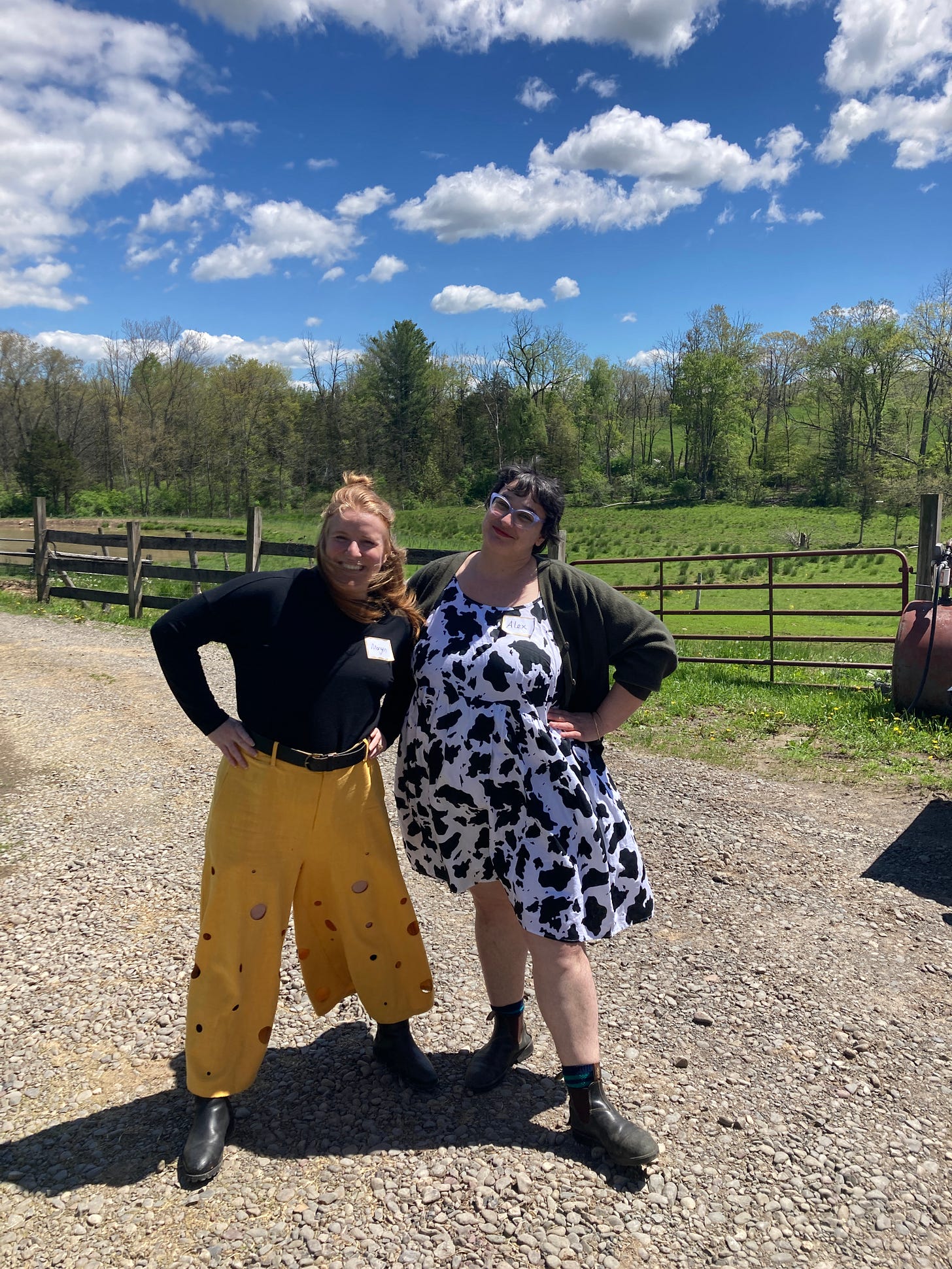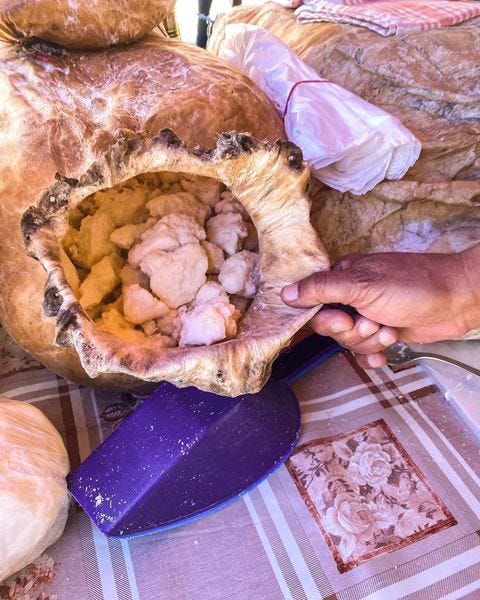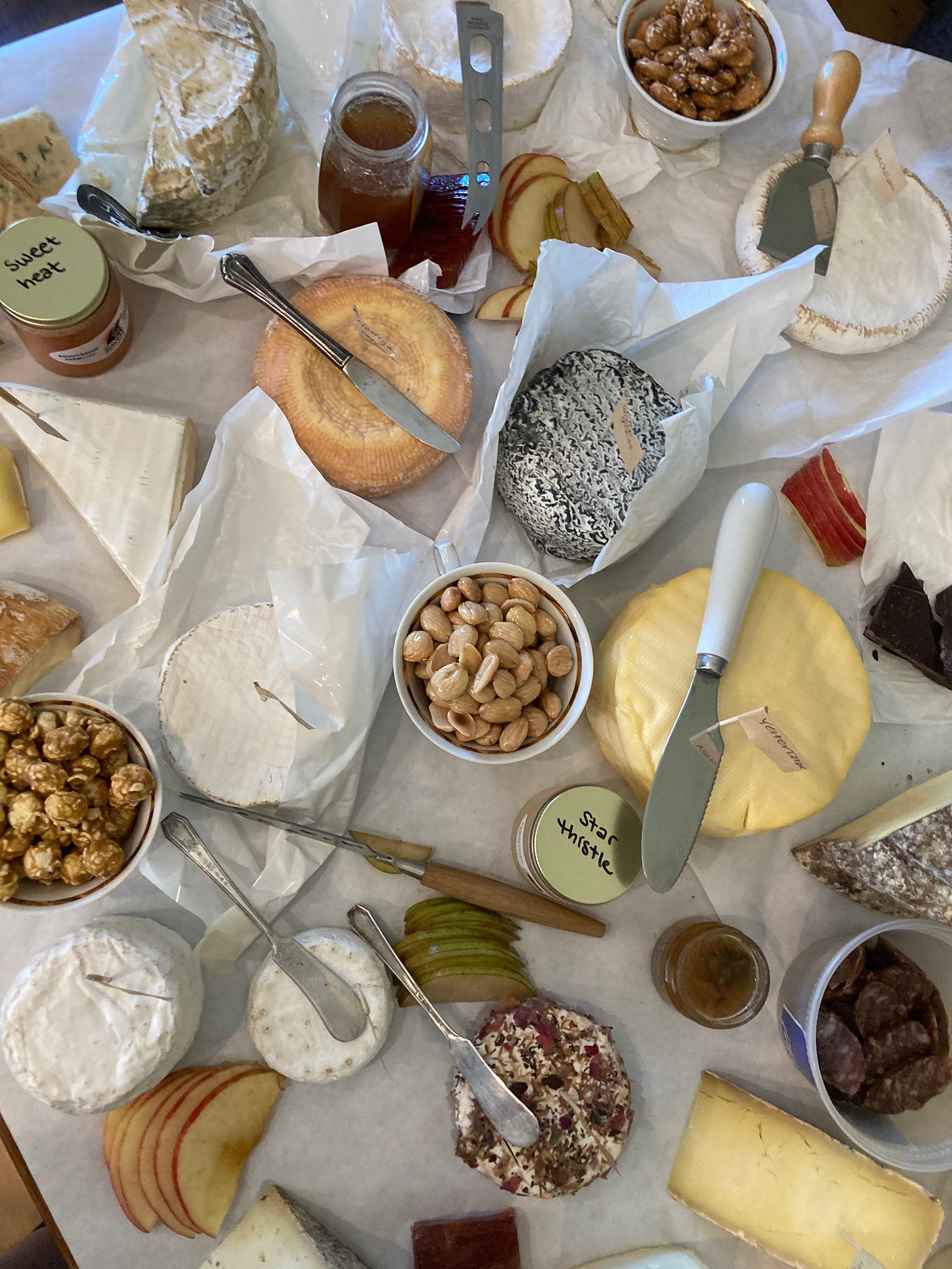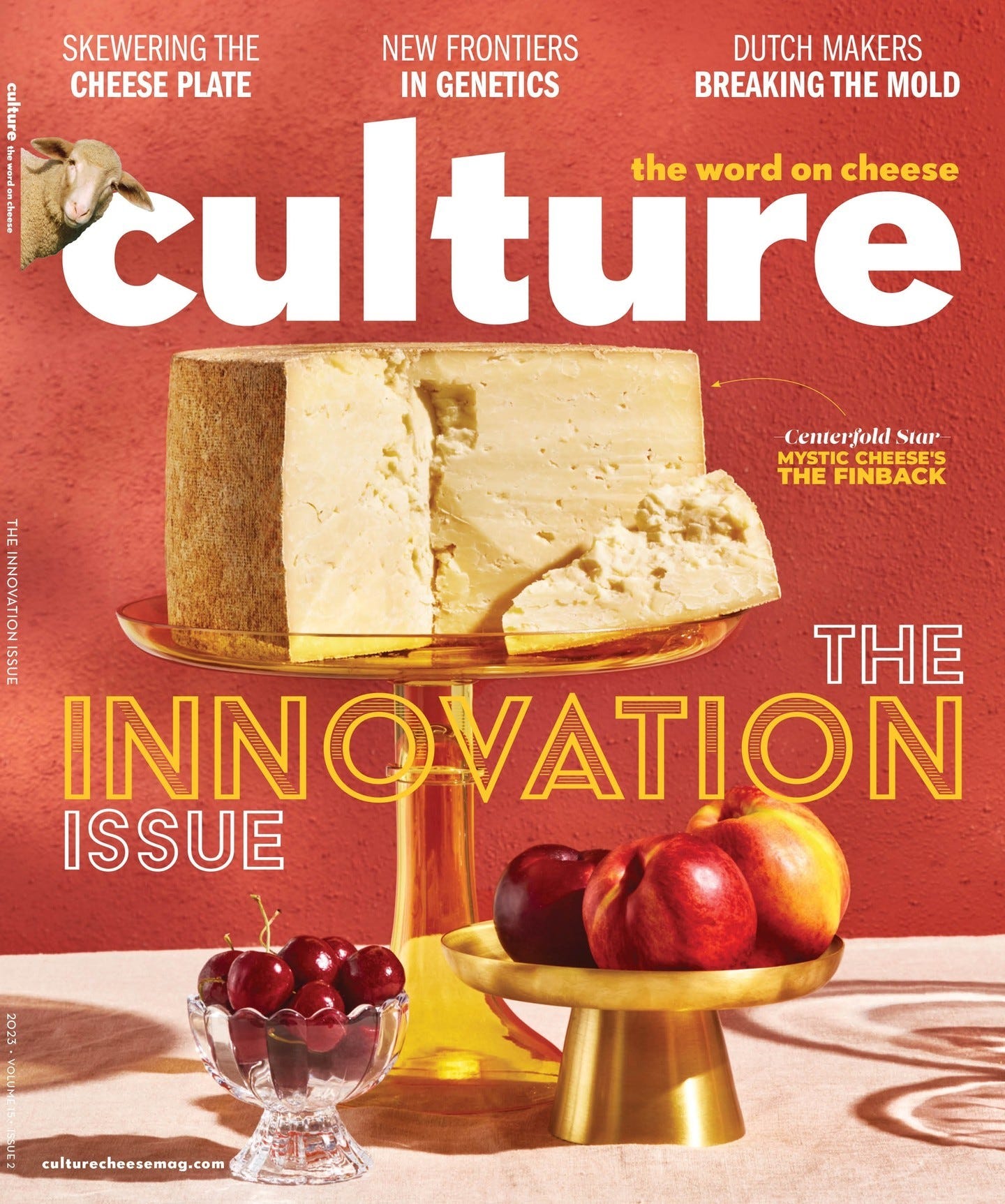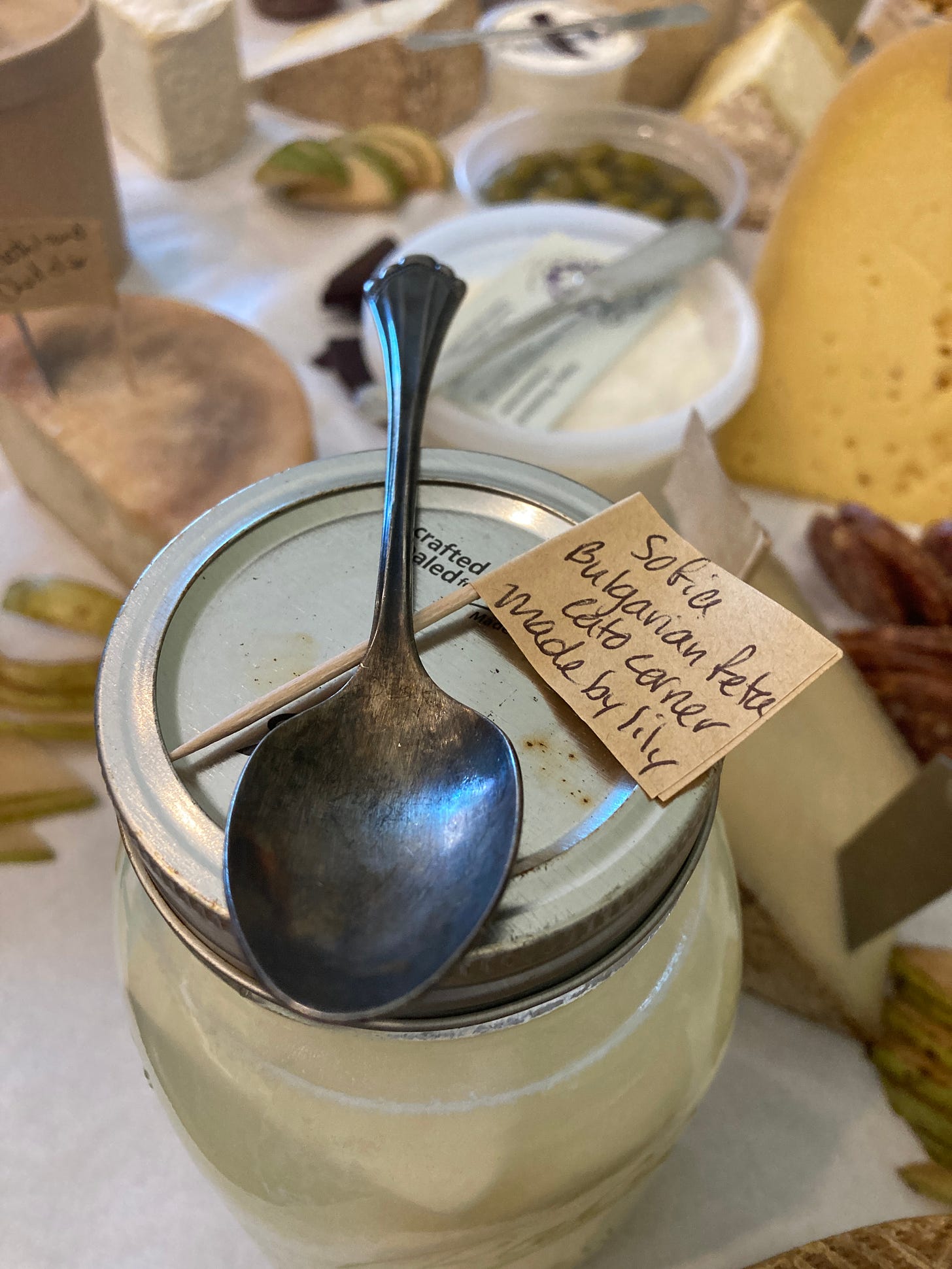Reflections on the Meeting of the Milkmaids
You may empower a woman by putting her in a room with 35 other lady cheese pros.

It’s been five days since the first-ever Meeting of the Milkmaids, and I’m still living in the afterglow.
Thirty-six women cheese professionals convened on a farm in Accord, New York for a day of learning and connection. There were mongers, makers, farmers, shop owners, educators, distributors, brokers, and writers. There was Cabot Clothbound mac ‘n’ cheese and surprisingly excellent gluten-free pastries. There were two inspiring women who presented their findings after years of research. There were violets and dandelions blooming in the pasture as we trekked up the hill for a post-lunch walk. There were lots of smiles and laughs and a few tears. And there was so, so much incredible cheese.
I rolled up to Catskill Wagyu in my Holstein-print dress after a rough night in my Airbnb, a budget-friendly RV on a nearby farm. (Staying across from a chicken coop seems quaint until you get a sunrise wake-up call from a rooster.) As I got out of my car and saw folks mingling by the barn where the meeting would take place, I felt the simmering panic of social anxiety creep up the back of my neck.
I shouldn’t have worried. I was greeted with literal open arms by some of my favorite milkmaids, like Katie Machen, a cheesemonger and writer in Queens who I originally met through a mutual friend’s early pandemic baking Zooms, and the cheese bruja herself, Izzie Ocampo. So was monger and educator Rachel Frier, who runs Finger Lakes-based events and travel company The Cheese Club (and co-created the OmaKäse, possibly the coolest cheese dinner I’ve ever been to). And I finally got to meet the ebullient Rachel Banks, cheesemaker-in-waiting for Ordinary Farmstead and moderator for the 35,000-member strong Learn to Make Cheese Facebook group, and the other Milkmaids organizers: Farmer and Catskill Wagyu co-owner Becky Collins Brooks, Cato Corner Farm cheesemaker Lily Orr, writer and photographer Babs Perkins, and cheesemaker Indigo Munoz-Weaver.
And it turns out that wearing cow print to a cheese-themed gathering is a great way to make new connections. I shared a table with monger and educator Kyra James, whose Own Your Funk is one of the more exciting cheese projects out there. I talked with Haley Rowland, a fifth-generation farmer who’s working on launching a cheese business on her family’s land in Connecticut. I was fascinated as Sarah Simiele shared the story of her journey from pre-med microbiology major to cheesemonger to owner of her own small but thriving cheese shop in Syracuse, The Curd Nerd. I bonded with Morgen Schroeder, owner of pandemic grazing board project-turned-cheese shop Martha’s Vineyard Cheesery, over our dairy-themed apparel.
After breakfast, we settled in to hear monger and Daphne Zepos Research Award 2021 recipient Mary Casella share some of her research on the historical relationship between women and cheese. For millennia, dairy production was seen as the domain of women—something we were naturally suited to, work that men would never touch—until the Industrial Revolution, when food production became a commodity to be exploited for profit rather than a way to feed one’s community.
The knowledge that women had shared with each other and passed down for generations was stolen by men seeking to systematize and scale it up. Women, especially those of middle- and upper-class status, were confined to the domestic sphere to care for home and children and husband—hidden labor that was nonetheless not considered “work.”
Mary’s research bumps up against a really fascinating intersection of biology, labor, power, and patriarchy that feel especially relevant right now, when so many are feeling the ill effects of late-stage capitalism, and our understanding of gender is becoming more nuanced and inclusive. Her stories of the sexism she’d experienced in her career as a monger struck a nerve, too: During the discussion, just about everyone had similar stories to share, from unequal treatment by bosses and supervisors to salespeople and service providers ignoring women business owners in favor of male partners or coworkers.
I’d seen Mary present virtually before as part of her DZRA award, but I wasn’t familiar with the work of writer and photographer Babs Perkins, who has spent the last ten years traveling through Bosnia, Herzegovina, Serbia, Croatia, and Montenegro to document what she believed to be the region’s vanishing traditional cheesemaking practices—”looking at the world through cheese as my lens,” as she described it.
A decade later, Babs admits that she was wrong: These practices have endured, despite the fallout of war 30 years ago still affecting daily life. For the people making sir iz mijeha (“cheese in a sack”), it’s about earning a livelihood, carrying on a tradition, and expressing each state’s unique cultural take on the region’s centuries-old cheesemaking heritage. As Babs put it, “It’s not about the cheese. It’s about what the cheese represents.” And telling that story does make a difference. Thanks in part to her work, some of the women cheesemakers she knows there have received funding to create tourism opportunities highlighting their cheeses.
Babs’s photographs are incredible (you can see more on her website and Instagram), but what I think wowed us the most—and even drew tears from a few folks—was the passion, openness, and intensity with which she shared the research she’s devoted herself to. What began as a talk about cheesemaking traditions in the former Yugoslavia became a fiery motivational speech about how wherever you are, whatever dead ends you hit, that’s where you’re meant to be—because you’ll keep going or start over or try again and find your way to the next step. I’m pretty sure every single person in the room needed to hear that.
Later, we broke out into small groups to discuss some of the issues we’d experienced in our professional lives as women—everything from uniforms being designed for “male” bodies to pay discrimination to impostor syndrome—then reconvened to talk through our experiences and potential solutions. Finally, it was time to attack the board of women-made cheeses (most from commercial creameries but some homemade gems, too) laid out by Morgen and Lily, and after lingering and talking for as long as possible, say our goodbyes.
I sometimes have mixed feelings about women-only spaces. Many I’ve been a part of feel like a refuge—a place where we get a break from the gendered dynamics that often shade interactions and relationships with men, whether they’re partners, friends, coworkers, bosses, or randos on the street or online. Each woman in that room has their own unique combination of experiences and identities and viewpoints, but we were brought together because of two factors that cut through the rest: our womanhood (however we choose to claim and define it) and cheese. There’s something so freeing and opening and comforting about being in a roomful of strangers and knowing you share something so foundational to the way you all move through the world and experience life, despite all the differences each person brings to the table.
But defining ourselves as women first can feel like a form of self-segregation that reinforces the gender binary rather than softening it, or like we’re aligning ourselves with the empty promises of girlboss feminism. I felt this tension during Mary’s talk: she told a story of going to the cheese festival in Bra, Italy in 2021 to see a panel of women cheesemakers. She felt so energized by their discussion, until one of the participants said afterwards: Why do I have to be a woman cheesemaker? Why can’t I just be a cheesemaker?
Are these our only options? To forever have a qualifier in front of what we do and who we are, or to have the identities and experiences that define us in such fundamental ways ignored? I scribbled in my notes: What is a third way?
To me, the answer is intersectional. It’s rejecting the gender binary while acknowledging that the either-or categories we push against shape who we are in inescapable ways. It’s nuancing the conversation about women to include race, class, ethnicity, sexuality, gender identity, body size, immigration status, nationality, marital status, whether you have kids or want them or are happily childfree.
The wonderful thing is that almost all of these topics came up on Saturday, whether explicitly by speakers or organically in group discussions or breakout groups or individual conversations (at least the ones I was having). In that group of more than 30 women, there was space for all of who we are.
Thanks again to Lily, Becky, Indigo, Rachel, and Babs for the time and effort they put into making this magic happen! I can’t wait for Milkmaids 2024.
Recent Work
Culture’s 2023 Innovation issue is out, which means you can read not one but two stories I’ve been working on since last fall! I talked to dairy farmers about the breeding techniques they’re using to create healthier animals, stronger farms, and better cheese. I also got to spotlight my favorite dish at an incredible restaurant here in Philly that’s owned by one of my former editors.
Recent Cheese
There were plenty of incredible women-made cheeses on the big board at Milkmaids—too many to count and way too many to taste in a single afternoon. One of the two that sticks out most in my mind was one of the rustic-rinded tommes North Jersey maker Jess Clark sells as Nonchalant Cheese, previewing a rich, sea-salty paste with aromas of apricot and honey. The other was a jar of Sofia, Cato Corner’s Bulgarian feta-style cheese, made by Milkmaids organizer Lily. I’m a sucker for brined cheeses like this one, which is technically not a feta at all, since that name can legally be used for Greek cheeses only.
Instead, the Bulgarians call their brined cheese sirene, which simply means “cheese” but, I like to think, speaks to its irresistible allure. Sofia has a delicate flavor and moist, almost spoonable texture that reminded me of the way fluffy, tender pancakes release the maple syrup they’ve soaked up when you bite down on a forkful.
When I raved about her cheese, Lily told me how she cuts the curd into tall columns rather than small pieces that will release more whey, as is done for firmer Greek feta. The curds are then allowed to drain under their own weight. This gentle treatment creates a soft, tender curd that holds more moisture. When it was time to divvy up the spoils, I grabbed the half-full jar of Sofia first. After I got home on Sunday night, I added it to a recovery salad of lettuce and radishes from my garden, farmers’ market carrots, and toasted sunflower seeds.
Recent Reads
A few links to tide you over till the next Milkfed.





